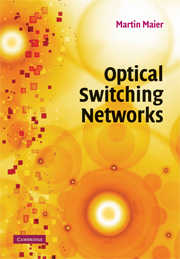Book contents
- Frontmatter
- Contents
- List of illustrations
- List of tables
- Preface
- Acknowledgments
- Part I Introduction
- Part II Optical wide area networks
- Overview
- 5 Generalized multiprotocol label switching
- 6 Waveband switching
- 7 Photonic slot routing
- 8 Optical flow switching
- 9 Optical burst switching
- 10 Optical packet switching
- Part III Optical metropolitan area networks
- Part IV Optical access and local area networks
- Part V Testbeds
- Bibliography
- Index
6 - Waveband switching
from Part II - Optical wide area networks
Published online by Cambridge University Press: 10 May 2010
- Frontmatter
- Contents
- List of illustrations
- List of tables
- Preface
- Acknowledgments
- Part I Introduction
- Part II Optical wide area networks
- Overview
- 5 Generalized multiprotocol label switching
- 6 Waveband switching
- 7 Photonic slot routing
- 8 Optical flow switching
- 9 Optical burst switching
- 10 Optical packet switching
- Part III Optical metropolitan area networks
- Part IV Optical access and local area networks
- Part V Testbeds
- Bibliography
- Index
Summary
We have seen in Chapter 5 that generalized multiprotocol label switching (GMPLS) networks are able to support various switching granularities, covering fiber, waveband, wavelength, and subwavelength switching. To realize GMPLS networks, the underlying network nodes need to support multiple switching granularities rather than only one. Hence, ordinary optical cross-connects (OXCs) that perform only wavelength switching, such as the one shown in Fig. 1.5, must be upgraded in order to support multiple switching granularities, leading to so-called multigranularity optical cross-connects (MG-OXCs). Compared to ordinary OXCs, MG-OXCs hold great promise to reduce the complexity and costs of OXCs significantly by switching fibers and wavebands as an entity without demultiplexing the arriving WDM comb signal into its individual wavelengths, giving rise to waveband switching (WBS).
Recently, WBS has been receiving considerable attention for its practical importance in reducing the size and complexity of photonic and optical cross-connects. Due to the rapid development and worldwide deployment of dense wavelength division multiplexing (DWDM) technologies, current fibers are able to carry hundreds of wavelengths. Using ordinary wavelength-switching cross-connects would require a large number of ports. WBS comes into play here with the promise to reduce the port count, control complexity, and reduce the cost of photonic and optical cross-connects. The rationale behind WBS is to group several wavelengths together as a waveband and switch the waveband optically using a single input and a single output port instead of multiple input/output ports, one for each of the individual wavelengths of the waveband. As a result, the size of ordinary cross-connects that traditionally switch at the wavelength granularity can be reduced, including the associated control complexity and cost (Cao et al., 2003b).
- Type
- Chapter
- Information
- Optical Switching Networks , pp. 77 - 83Publisher: Cambridge University PressPrint publication year: 2008



